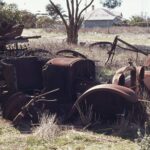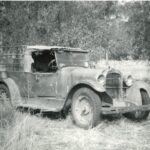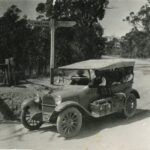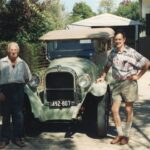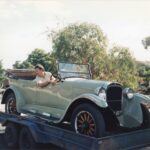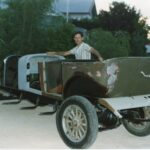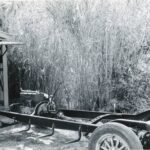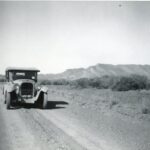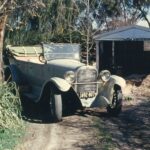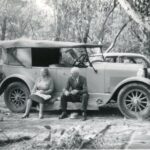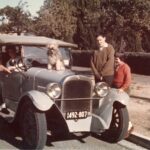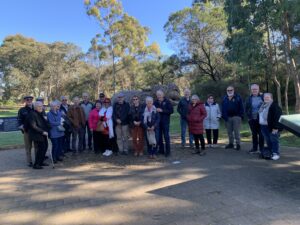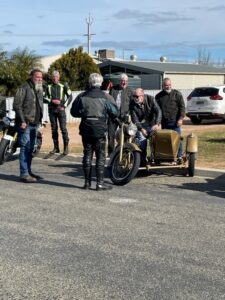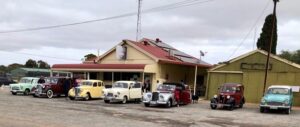In response to receiving the People’s Choice Trophy, at a recent National rally of the Dodge Brothers Club of Australasia at Tanunda SA, I have prepared an article about our Dodge for our Radiator magazine.
At the young age of 19, why was I so keen to own and drive a Dodge as my first car? The following background goes back to my grandfather, Duncan McRae Wood who bought a new Dodge 4 tourer in 1918 from the Cheney Motor Company in Broken Hill. Duncan’s work with the AMP Company, required considerable outback travel, visiting station properties in northern and western New South Wales. My father, Tom Wood has written in some detail of their family’s road trips in a family publication “Dust, Bumps and Mileposts”. Between 1920 and 1932 the Wood family travelled almost annually the long and dusty roads from NSW to visit my grandmother’s family farm (“Bayfield”) between Clare and Burra. in SA. They also made an epic journey from Dubbo NSW to Victor Harbor in a new 1920 Dodge tourer. (see photo) My father, Tom was almost 2 years old at that time. What a trip that must have been!
During the late 1940’s and into the early 1960’s, being the oldest of Duncan’s grandchildren, I had many holidays on their 52-acre Wood mixed farm at Clare. After the evening meal, we would sit in the dining room and besides listening to the popular radio quiz shows of that time; grandad would reminisce of his former motoring trips and adventures, mostly in NSW. I quickly learned that Dodge 4 cars of the 1920’s had a fine reputation for dependable motoring. The term “the Old Dodge” became a household name in the Wood family!
My first experience of driving a Dodge 4 was during a holiday at Bayfield in 1956. I was asked to steer their 1925 Dodge buckboard when feeding hay to the sheep. I was hooked, and from that time onward, I looked for any opportunity to drive the Dodge when staying there.
Fast forward to 1964, when I had completed two years of a 4-year Agricultural Science course at the University of Adelaide. The third year of the course was based at the Waite Institute at Urrbrae, and I was sure that I needed my own wheels to commute from home in Blackwood to attend lectures and practical work. Dad and I had been looking around for a suitable car for some time and I was hoping for a Dodge! One evening, Dad told me he had seen a grey 1925 Dodge tourer for sale in a car yard at Wingfield, a northern Adelaide suburb!
Early the next morning, a Saturday, we drove out to Wingfield, and there in the front row of a rather small car lot was a tidy looking grey Dodge tourer with a khaki canvas top. I must have looked very keen, so we asked the proprietor to take us for a demo drive. After attaching his trade plates, and starting the engine, he pointed to the full scale oil pressure gauge reading and inferred that the engine was in good condition, but of course we dodgy people know that the oil pressure gauge on a Dodge 4 just indicates that the oil pump and splash feed are working! The car started easily and seemed to run well; the brakes worked well enough to skid the back wheels, so we agreed to buy the Dodge for the asking price of £45 ($90) “full & final”. I still have the receipt! The odometer reading at the time of purchase was just under 93 000 miles and the registration number was S/A 45-678.
In those days it was permissible to tow an unregistered vehicle, so Dad agreed to tow it home using a steel tow rope supplied by the car salesman, with me at the wheel of the Dodge. We arrived home at Blackwood thankfully without incident after a long tow. It was an exhilarating experience for me and maybe a little nerve racking for Dad, but I appreciate his help to fulfil my dream of owning and driving a Dodge!
As soon as the Dodge was home I gave it a thorough checking over. I started scraping off a lot of hard grease around the engine and transmission that had accumulated over 39 years of use. Some grease was a hard as a rock. There were some normal maintenance issues needing my attention including an engine oil change, gearbox and diff oil level checks. Then the clutch and fan grease cups needed filling, and of course, a thorough chassis lubrication.
I have not been able to trace the history of the car despite the distinctive registration number S/A 45-678 but Dad thought it was owned by a fisherman on the Coorong. As I was keen to register the car for normal use, I wasted no time registering the car and was issued a new numeric plate S/A 492-807.
After a few local trips, I noticed the engine was pulling unevenly and a compression test confirmed loss of compression on number 2 cylinder. This was a bit disappointing to me, but Dad had some friends in the motor trade and I had an uncle who loaned me some basic tools including an old Alemiite grease gun. Once the cylinder head was removed, it was clear that a new S32 exhaust valve was required for cylinder no.2 and all the valve seats needed some relieving.
Soon I invested in a small set of AF sockets, several open enders and some feeler gauges essential maintenance tools for any Dodge owner! One of Dad’s friends loaned us a tension wrench to help me get the head evenly tensioned.
At that time spare parts, (eg head gaskets and exhaust manifold gaskets) tyres, tubes and rust bands were still readily available at reasonable prices. That was a big help to me on a student cadetship of $23.45 per fortnight. There was enough income to buy fuel for the car, some minor servicing and to pay a little board to my parents!
It’s worth mentioning that this Dodge was (and still is) equipped with magneto ignition and still had the original Clum ignition key. The 20” hickory spoked wheels were a bit worn and the tyres 5.50×20 6 ply were serviceable but barely legal by today’s standards! The body number on the toe board was A395-055, placing the date of manufacture in late July 1925. (1926 Series).
A little later that year, while the Dodge was off the road due to engine repairs, I was offered a complete 1925 Dodge tourer located in Hyde Park, a nearby suburb! I could hardly wait to tell Dad about it! And so, on the next Saturday afternoon, Dad & I inspected it and after thanking the donor, towed home what I will refer to as the “Blue Dodge”. This car tuned out to be a huge blessing as a source of spare parts including four excellent 20” wheels and two brake drums, engine, a nice quiet gearbox, magneto, vacuum tank and more! It was basically a low mileage car with no top and a few dents!
However, because my parents needed a relatively tidy back yard, (no old motor bodies allowed!) I was unable to keep the body, chassis or mudguards. I did my best to salvage all the parts I could at the time. Sadly, Dodge tourer no.1, because it was equipped with a towbar, was required to haul our neighbour’s trailer loaded with Blue Dodge body items (including to tub section) to the Mitcham dump!
Now that I had a few second-hand Dodge spare parts, I was looking for an outback adventure! In August 1964, I chose to take the Dodge on a week’s trip to the Flinders Ranges. One of my mates from the Ag. Science course was keen to join me on this rough camping trip and apart from a couple of minor hiccups, the Dodge performed very well visiting a range of attractions including Alligator Gorge, Wilmington, Hawker, Wilpena Pound, Blinman, Parachilna, Quorn, Port Augusta, Port Pirie and Port Broughton; all these places were new to me. Of course, it was quite a distance to cover in 7 days, with unsealed roads north of Wilmington and Port Augusta. The Dodge proved to be dependable, and even with some night driving, we avoided any kangaroo incidents.
After the Flinders trip I decided to have the worn engine from the “Blue Dodge” reconditioned by Southcott Ltd in Adelaide, where we had some helpful contacts. Dad also had a stainless-steel water pump shaft made to correct that common leaking water pump problem on Dodge 4’s. By my 21st birthday in May 1965, I had swapped the engines and installed the less worn transmission, also from the Blue Dodge into Dodge tourer no.1.
The Dodge tourer was then in good condition to use for all my travels and social engagements until I began working for the SA Department of Agriculture as a Research Officer in Agronomy. In early 1966, I did not enjoy the commute across Adelaide in peak hour traffic to work at Northfield Laboratories. I needed a more appropriate vehicle so I bought a second-hand 1959 Holden FC sedan but I kept the tourer registered until April 1967. In the meantime, I had arranged for a prefabricated garage to be erected at my parents’ place so that I could begin dismantling the Dodge for restoration.
Between 1966 and 1969 my job involved a lot of country travel to experimental sites in the Murray Mallee, and in 1969, Carolyn and I were married and in January 1970, we moved to Cleve on Eastern Eyre Peninsula for five years. In January 1975, we moved to Loxton to a Government rental home. Despite my best intentions, Dodge no.1 remained in Adelaide in a semi dismantled state until we moved into our own home in Loxton in January 1979.
Another miracle in this long saga occurred in 1976, when, on a routine farm visit at Parilla in the southern Mallee I spotted the rusty remains of a Dodge 4 under a Mallee tree. The two front mudguards looked pretty good, just surface rust, so I offered the farmer $20 for it and he offered help me load it on a trailer with a jib crane! That was a great deal because, in addition to the mudguards, the engine yielded four oversize aluminium pistons, a magneto and a water pump shaft; all turned out to be very helpful in the long term.
I joined the Riverland Vintage & Classic Car Club (RV&CCC) in 1975 and I started to look around for a vintage car that had the potential to use for Club events. So, in February 1977, through another club member I learned that a retired grape buyer in Barmera had a 1926 Dodge 4 buckboard “that could be for sale”! It was certainly worth a look, so Carolyn and I visited the owner to inspect it. Although in a very sorry state, and the owner said there was a starter problem, I could see it had potential, so after due consideration, we bought it and arranged to take it back to our rented home in Loxton. It wasn’t long before I had fixed the starter-generator problem a/c my previous experience with Dodges resulted in a roadworthy buckboard that our growing family could enjoy on Car Club outings. This we enjoyed very much until 1994, when we sold it to help finance restoration of our tourer.
For several years beginning in 1976, I was among several members of the RV&CCC to attend a panel beating and panel repair class in the Riverland. I learned how to use of oxy-acetylene in fusion welding patches and shrinking patched and joined steel panels. I found these techniques very useful in repairing valance panels and mudguards which I then primed for the panel and painting shop some ten years later!
Eventually, our partly dismantled tourer no.1 arrived during 1979 to our new home in Loxton to occupy one bay of our spacious 3-bay garage, alongside the 1926 Dodge buckboard. While family and work life seemed busy, small steps were made in the tourer restoration. I had already renewed most of the rotten timber in the rear (tub) section of the tourer during my spare time, before moving to Cleve. I had also stripped all the blue enamel off the Blue Dodge wheels, sanded them down and applied a couple of coats of clear marine varnish. Those wheels look as good today as they looked 50 years ago!
During 1982, I must have found the spare time to swap the reconditioned “Blue Dodge” engine out of the tourer into the buckboard. The engine in the buckboard was tired, so in 1983 I sent that engine and the original tourer engine to be reconditioned by Jeff James in Adelaide. Both were rebored and had oversized pistons fitted, all the white metal main and big end bearings were renewed and line bored, new valve guides installed and crankshaft balanced. Its original engine, now reconditioned, was put back into the buckboard and the tourer was fitted likewise. It became a rolling chassis again, ready to receive the body work and in early 1993, the tourer was sent to Blue’s Crash (a Loxton panel and painting shop) to assemble and paint.
It took several months for Blue to finish assembling the body and painting it, as it wasn’t a priority job, but later that year our second daughter asked me to hurry up and finish the restoration, as she would like it to be ready for her wedding in April 1994! I reckon I had 6 months to find a motor trimmer and sell the buckboard to finance that final step.
Again, a couple of RV&CCC members recommended Mr Alby Hodgins, a retired motor trimmer living in Mount Barker. He was able to order the hooding or top material that we had already selected from the UK and I fitted 4 new hood bows. I was looking into buying brown vinyl upholstery for the seats and door linings, when a friend offered to us a significant quantity of imported Scottish leather. After checking that the motor trimmer could use this gifted leather, I gratefully accepted it as another miracle I this long and amazing saga of our Dodge restoration.
As we are now into 2024, I am a little surprised to learn that I will have owned this Dodge tourer for 60 years this March, and that it has been on the road as a ground-up restoration for 30 years! What a blessing this car has been to many!
Richard & Carolyn, Loxton
Photos & captions
IMG_865 My first car outside the family home in Blackwood in 1964
IMG_866 My grandparents sitting on the running board at a family picnic
IMG_867 I bought a new garage for the Dodge in 1967
IMG_868 On a trip to the Flinders Ranges between Blinman and Parachilna
IMG_869 Dismantled to a running chassis only took one day in 1968!
IMG_870 At our new home in Loxton, the original khaki colour of the tub.
IMG_871 1993 back from the panel repair and paint shop
IMG_872 March 1994 Loaded for the trip to the motor trimmer.
IMG_873 Alby Hodgins, retired motor trimmer in Mount Barker did an excellent job.
IMG_874 Ready for the first family wedding April 1994.
IMG_875 Grandad’s family trip to Victor Harbor from Dubbo NSW 1920
IMG_876 The Bayfield Dodge 4 buckboard – I had my first drive in 1956.
ING_877 These rusty remains, found in 1976, yielded some valuable parts!
